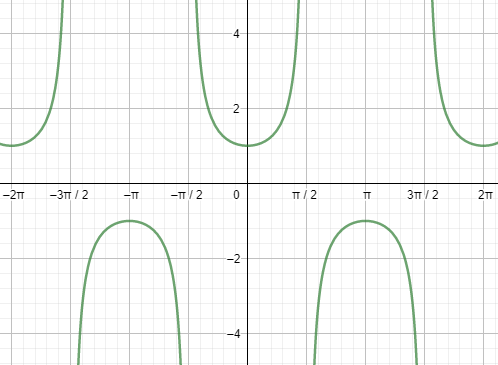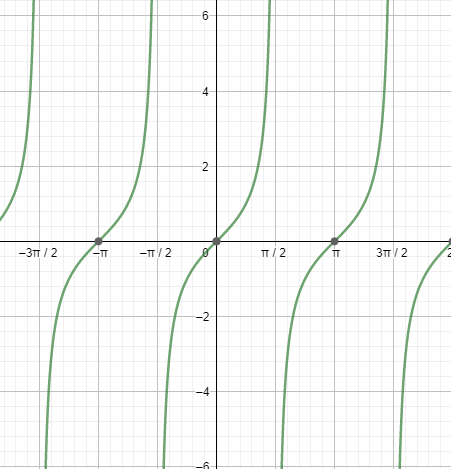
Answer
485.1k+ views
Hint: Try to simplify the left-hand side of the equation that we need to prove by using the properties that $\tan \theta =\dfrac{\sin \theta }{\cos \theta }\text{ and }\cot \theta =\dfrac{\cos \theta }{\sin \theta }$ , and other related formulas.
Complete step-by-step solution -
Before moving to the solution, let us discuss the periodicity of the secant and tangent function, which we would be using in the solution. All the trigonometric ratios, including secant and tangent, are periodic functions. We can better understand this using the graph of secant and tangent.
First, let us start with the graph of secx.

Next, let us see the graph of tanx.

Looking at both the graphs, we can say that the graphs are repeating after a fixed period i.e. $2{{\pi }^{c}}$ . So, we can say that the fundamental period of the secant function and the tangent function is $2{{\pi }^{c}}=360{}^\circ $
We will now solve the left-hand side of the equation given in the question.
$\dfrac{\tan \theta -\cot \theta }{\sin \theta \cos \theta }$
Now we will use the properties that $\tan \theta =\dfrac{\sin \theta }{\cos \theta }\text{ and }\cot \theta =\dfrac{\cos \theta }{\sin \theta }$ . On doing so, we get
$\dfrac{\dfrac{\sin \theta }{\cos \theta }-\dfrac{\cos \theta }{\sin \theta }}{\sin \theta \cos \theta }$
$=\dfrac{{{\sin }^{2}}\theta -{{\cos }^{2}}\theta }{{{\sin }^{2}}\theta {{\cos }^{2}}\theta }$
$=\dfrac{{{\sin }^{2}}\theta }{{{\sin }^{2}}\theta {{\cos }^{2}}\theta }-\dfrac{{{\cos }^{2}}\theta }{{{\sin }^{2}}\theta {{\cos }^{2}}\theta }$
\[=\dfrac{1}{{{\cos }^{2}}\theta }-\dfrac{1}{{{\sin }^{2}}\theta }\]
Now we know that $\dfrac{1}{\sin \theta }=\cos ec\theta \text{ and }\dfrac{1}{\cos \theta }=\sec \theta $.
\[\therefore {{\sec }^{2}}\theta -\cos e{{c}^{2}}\theta \]
Also, we know that ${{\sec }^{2}}\theta =1+{{\tan }^{2}}\theta \text{ and }\cos e{{c}^{2}}\theta =1+{{\cot }^{2}}\theta $ .
\[1+{{\tan }^{2}}\theta -1-{{\cot }^{2}}\theta \]
\[={{\tan }^{2}}\theta -{{\cot }^{2}}\theta \]
As we have shown that the left-hand side of the equation given in the question is equal to the right-hand side of the equation in the question. Hence, we can say that we have proved that $\dfrac{\tan \theta -\cot \theta }{\sin \theta \cos \theta }={{\tan }^{2}}\theta -{{\cot }^{2}}\theta $.
Note: Be careful about the calculation and the signs while opening the brackets. The general mistake that a student can make is 1+x-(x-1)=1+x-x-1. Also, you need to remember the properties related to complementary angles and trigonometric ratios.
Complete step-by-step solution -
Before moving to the solution, let us discuss the periodicity of the secant and tangent function, which we would be using in the solution. All the trigonometric ratios, including secant and tangent, are periodic functions. We can better understand this using the graph of secant and tangent.
First, let us start with the graph of secx.

Next, let us see the graph of tanx.

Looking at both the graphs, we can say that the graphs are repeating after a fixed period i.e. $2{{\pi }^{c}}$ . So, we can say that the fundamental period of the secant function and the tangent function is $2{{\pi }^{c}}=360{}^\circ $
We will now solve the left-hand side of the equation given in the question.
$\dfrac{\tan \theta -\cot \theta }{\sin \theta \cos \theta }$
Now we will use the properties that $\tan \theta =\dfrac{\sin \theta }{\cos \theta }\text{ and }\cot \theta =\dfrac{\cos \theta }{\sin \theta }$ . On doing so, we get
$\dfrac{\dfrac{\sin \theta }{\cos \theta }-\dfrac{\cos \theta }{\sin \theta }}{\sin \theta \cos \theta }$
$=\dfrac{{{\sin }^{2}}\theta -{{\cos }^{2}}\theta }{{{\sin }^{2}}\theta {{\cos }^{2}}\theta }$
$=\dfrac{{{\sin }^{2}}\theta }{{{\sin }^{2}}\theta {{\cos }^{2}}\theta }-\dfrac{{{\cos }^{2}}\theta }{{{\sin }^{2}}\theta {{\cos }^{2}}\theta }$
\[=\dfrac{1}{{{\cos }^{2}}\theta }-\dfrac{1}{{{\sin }^{2}}\theta }\]
Now we know that $\dfrac{1}{\sin \theta }=\cos ec\theta \text{ and }\dfrac{1}{\cos \theta }=\sec \theta $.
\[\therefore {{\sec }^{2}}\theta -\cos e{{c}^{2}}\theta \]
Also, we know that ${{\sec }^{2}}\theta =1+{{\tan }^{2}}\theta \text{ and }\cos e{{c}^{2}}\theta =1+{{\cot }^{2}}\theta $ .
\[1+{{\tan }^{2}}\theta -1-{{\cot }^{2}}\theta \]
\[={{\tan }^{2}}\theta -{{\cot }^{2}}\theta \]
As we have shown that the left-hand side of the equation given in the question is equal to the right-hand side of the equation in the question. Hence, we can say that we have proved that $\dfrac{\tan \theta -\cot \theta }{\sin \theta \cos \theta }={{\tan }^{2}}\theta -{{\cot }^{2}}\theta $.
Note: Be careful about the calculation and the signs while opening the brackets. The general mistake that a student can make is 1+x-(x-1)=1+x-x-1. Also, you need to remember the properties related to complementary angles and trigonometric ratios.
Recently Updated Pages
What is IUCN A Indian Union for Conservation of Nature class 10 social science CBSE

The provision for the Contingency Fund of India as class 10 social science CBSE

Which country did Learie Constantine belong to A West class 10 social science CBSE

Adolf Hitler a Where was Adolf Hitler born b What was class 10 social science CBSE

Which one of the following is the artificial lake in class 10 social science CBSE

What is the National food for Work Programme NFWP class 10 social science CBSE

Trending doubts
How do you graph the function fx 4x class 9 maths CBSE

Which are the Top 10 Largest Countries of the World?

Fill the blanks with the suitable prepositions 1 The class 9 english CBSE

What is the meaning of sol in chemistry class 11 chemistry CBSE

The Equation xxx + 2 is Satisfied when x is Equal to Class 10 Maths

The capital of British India was transferred from Calcutta class 10 social science CBSE

Why is there a time difference of about 5 hours between class 10 social science CBSE

Capital of the Cheras was A Madurai B Muziri C Uraiyur class 10 social science CBSE

What organs are located on the left side of your body class 11 biology CBSE




